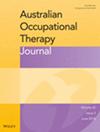Associations between physical activity, sedentary behaviour and cognitive domain performance of people living with mild cognitive impairment in the community
Abstract
Introduction
Physical activity is known to positively influence cognitive performance. For adults with mild cognitive impairment (MCI), the relationship between physical activity levels and cognitive performance is unknown. This cross-sectional study aimed to determine if cognitive performance [as measured by the Montreal Cognitive Assessment (MoCA)] of people living in the community with MCI is associated with their physical activity levels or sedentary behaviour.
Methods
ActivPAL™ accelerometers were used to objectively measure physical activity and sedentary behaviour for seven full days. Cognitive performance was measured using the MoCA.
Consumer and Community Involvement
No involvement other than as research participants
Results
Eighty-two participants from the Balance on the Brain randomised controlled trial were included. Most participants were retired (88%), with 33 (40%) reporting a fall in the last year. The median MoCA score was 24 (IQR 22–26). Participants achieved a mean of 6296 (±2420) steps per day and were sedentary for 10.6 (±2) hours per day. The only physical activity outcomes that had a fair, positive correlation were moderate- to vigorous-intensity physical activity measures of total stepping time and total number of steps (with a cadence of ≥100 steps/min) with the orientation MoCA domain score (r(82) = 0.36, p ≤ 0.001 and r(82) = 0.37, p ≤ 0.001, respectively). Higher total sedentary time had a weak, positive correlation with better visuospatial/executive performance (r(82) = 0.23, p = 0.041). The orientation outcomes remained significant when analysed in an adjusted logistic regression model.
Conclusion
This study found that performance in the MoCA orientation domain had a fair-positive correlation with moderate-intensity physical activity (i.e., stepping time and step count with a cadence of ≥100 steps/min) as measured by a thigh-worn accelerometer for community-dwelling older adults with MCI. When considering the relationship between cognitive domains and sedentary behaviour, consideration may be needed regarding whether cognitive enhancing activities (such as crosswords and other brain games) are being performed, which may confound this relationship. Further investigation is required to confirm these results.

 求助内容:
求助内容: 应助结果提醒方式:
应助结果提醒方式:


